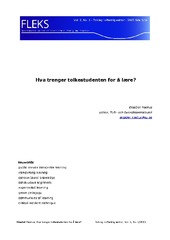| dc.contributor.author | Tiselius, Elisabet | |
| dc.date.accessioned | 2016-07-07T09:28:17Z | |
| dc.date.available | 2016-07-07T09:28:17Z | |
| dc.date.issued | 2015 | |
| dc.Published | FLEKS - Scandinavian Journal of Intercultural Theory and practice 2015, 2(1) | eng |
| dc.identifier.issn | 1894-5988 | |
| dc.identifier.uri | https://hdl.handle.net/1956/12292 | |
| dc.description.abstract | Students of public service interpreting come from a variety of backgrounds. A typical group of interpreting students includes a mix of students from different immigrant communities and from Norway’s majority population group, as well as students from varied educational backgrounds. Students have also had varying private and professional experiences with interpreting. This heterogeneity represents a challenge for teachers attempting to create a level playing field for all students, but it is also an asset for students, for instance because it creates communities of learning (Bielaczyc and Collins 1999). Furthermore, in the interpreter training field there is a lively methodological and didactic discussion, often with evidence-based pedagogical papers (Napier 2013). There are, however, fewer publications on general pedagogical approaches to interpreter training (Sawyer 2004 and Gile 2009 being important exceptions). This article looks at interpreter training in Norway and discusses the pedagogical approach it represents. The aim is to suggest how a level playing field in interpreter training can be created from a pedagogical and methodological perspective using common higher education methodologies such as critical incident technique (Chell 2004), constructive alignment (Biggs 2003) and experiential learning (Kolb 1984), several of which are already in use in interpreter training in Norway. | en_US |
| dc.language.iso | nob | eng |
| dc.publisher | International Studies, Oslo and Akershus University College of Applied Sciences | eng |
| dc.rights | This work is licensed under a Creative Commons Attribution 4.0 International License. | eng |
| dc.rights.uri | https://creativecommons.org/licenses/by/4.0/ | eng |
| dc.subject | public service interpreter training | eng |
| dc.subject | interpreting training | eng |
| dc.subject | context based knowledge | eng |
| dc.subject | constructive alignment | eng |
| dc.subject | experiential learning | eng |
| dc.subject | genre pedagogy | eng |
| dc.subject | communities of learning | eng |
| dc.subject | critical-incident technique | eng |
| dc.title | Hva trenger tolkestudenten for å lære? | eng |
| dc.type | Peer reviewed | |
| dc.type | Journal article | |
| dc.date.updated | 2016-04-11T07:45:40Z | |
| dc.description.version | publishedVersion | |
| dc.rights.holder | Copyright (c) 2015 Elisabet Tiselius | eng |
| dc.identifier.cristin | 1211823 | |
| dc.subject.nsi | VDP::Samfunnsvitenskap: 200::Pedagogiske fag: 280 | |
| dc.subject.nsi | VDP::Humaniora: 000::Språkvitenskapelige fag: 010 | |

